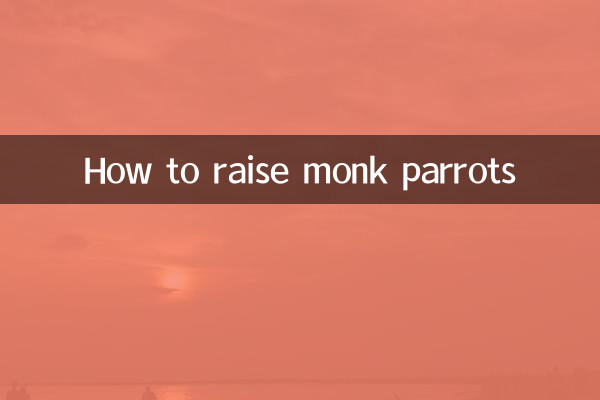Title: How to raise monk parrots
Monk Parakeet is a smart and lively parrot. Because of its docile personality and strong adaptability, it has become the first choice pet for many bird lovers. This article will combine popular topics and hot contents on the Internet for the past 10 days to introduce you in detail the breeding methods of monk parrots, including precautions in terms of diet, environment, training, etc.
1. Basic introduction to monk parrot

Monk parrot is native to South America, with a medium body size, about 30 cm long, mainly green in feathers and grayish-white abdomen. They are known for their ability to imitate human language and group habits, and their lifespan can reach 15-20 years.
| feature | describe |
|---|---|
| Body length | About 30 cm |
| Feather color | Mainly green, gray and white abdomen |
| life | 15-20 years |
| character | Smart, lively, gentle |
2. The breeding environment of monk parrots
Monk parrots need a spacious and safe cage that should be equipped with perches, toys and food pots. The cage size is recommended to be at least 60 cm x 60 cm x 90 cm to ensure that the parrot has enough room to move.
| Feeding environment requirements | Specific instructions |
|---|---|
| Cage size | At least 60cm×60cm×90cm |
| Perch | Diameter 2-3 cm, natural wood is the best |
| Toy | Provide climbing ropes, bells, etc. |
| temperature | Stay at 18-25℃ |
3. The diet of monk parrots
The diet of monk parrots should be mainly special parrot food, supplemented by fresh fruits, vegetables and a small amount of nuts. Avoid feeding foods containing sugar, salt or additives.
| Food Type | Recommended food |
|---|---|
| Staple food | Special parrot food |
| fruit | Apples, pears, bananas (cores) |
| vegetable | Carrots, broccoli, spinach |
| nut | Almonds, walnuts (small amount) |
4. Training and interaction of monk parrots
Monk parrots have a high IQ and can learn simple instructions and imitate human language through training. Rewards should be the main focus during training to avoid coercion or punishment.
| Training Programs | method |
|---|---|
| Instruction training | Reward with snacks, repeat simple instructions |
| Language imitation | Repeat fixed vocabulary every day |
| Social interaction | At least 1 hour of interaction per day |
5. The health management of monk parrots
Regularly check the health of the monk parrot, including the status of feathers, eyes, beak and claws. If abnormalities are found, seek medical treatment in time.
| Health Checkup Program | Things to note |
|---|---|
| feather | Is it smooth and no falling off |
| Eye | Is it bright and no secretions |
| Beak and claws | Is it too long or abnormal |
| stool | Is the color and shape normal? |
6. Popular topics and hot content
According to data from the entire network for nearly 10 days, popular topics about monk parrots mainly focus on "how to train parrots to speak" and "dietary taboos for monk parrots". The following are some hot contents:
| Hot Topics | Discussion focus |
|---|---|
| Training parrots to speak | Best training time and method |
| Dietary taboos | What foods are harmful to parrots |
| Cage layout | How to create a comfortable living environment |
| Health issues | Prevention and treatment of common diseases |
Through the above content, I believe you have a more comprehensive understanding of how to raise monk parrots. Monk parrots are a very fun pet, and they will become a happy companion in your life as long as they provide the right environment and careful care.

check the details

check the details